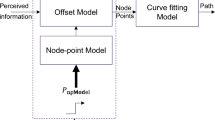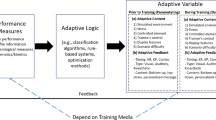Abstract
This paper proposes a novel method of analysing trajectories followed by people while they perform navigational tasks. The results indicate that modelling trajectories with Bézier curves provides a basis for the diagnosis of navigational patterns. The method offers five indicators: goodness of fit, average curvature, number of inflexion points, lengths of straight line segments, and area covered. Study results, obtained in a virtual environment show that these indicators carry important information about user performance, specifically spatial knowledge acquisition.
Similar content being viewed by others
References
Adobe Systems Incorporated (1990) PostScript language reference manual, 2nd edn. Addison-Wesley, Reading, Massachusetts, p 393
Aggarwa J, Cai Q (1997) Human motion analysis: a review. In: Proceedings of IEEE nonrigid and articulated motion workshop, pp 428–440 Au: Pl. check author name in Ref. [2]
Agrawala M, Stolte C (2001) Rendering effective route maps: improving usability through generalization. In: Computer graphics: a quarterly report of ACM SIGGRAPH, vol 18, pp 241–250
Allen G (1982) The organization of route knowledge, new directions for child development. Child Conceptions Spat Relat 15:31–39
Allen G (1999) Cognitive abilities in the service of wayfinding: a functional approach. Prof Geogr 51(1):554–561
Arakawa A, Hyyama M, Emura T et al (1995) Trajectory generation for wheeled mobile robot based on landmarks. In: Proceedings of IEEE international conference on systems, man and cybernetics, vol 2, pp 1273–1278
Arthur A, Passini R (1992) Wayfinding: people, signs, and architecture. McGraw–Hill, New York
Bartels R, Beatty J, Barsky B (1998a) An introduction to splines for use in computer graphics and geometric modelling. Morgan Kaufmann, San Francisco, CA, pp 211–245
Bartels R, Beatty J, Barsky B (1998b) An introduction to splines for use in computer graphics and geometric modelling. Morgan Kaufmann, San Francisco, CA
Bashir F, Khokhar A, Schonfeld D (2004) A hybrid system for affine-invariant trajectory retrieval. In: Proceedings of the 6th ACM SIGMM international workshop on multimedia information retrieval. ACM, New York, pp 235–242
Bock RK, Krischer W (1998) Data analysis briefbook. Springer, Berlin. URL: http://rkb.home.cern.ch/rkb/AN16pp/node1.html (version current as of May 02, 2003)
Boulic R, Noser H, Thalmann D (1994) Automatic derivation of curved human walking trajectories from synthetic vision. In: Proceedings of IEEE computer animation, pp 93–103
Bowman D, Davis E, Badre A et al (1999) Maintaining spatial orientation during travel in an immersive virtual environment. Presence: Teleoper Virtual Environ 8(6):618–631
Chaudhari A, Bragg R, Alexander E et al (2001) A video-based, markerless motion tracking system for biomechanical analysis in an arbitrary environment. In: BED bioengineering conference ASME, vol 50, pp 777–778
Chen L, Özsu M, Oria V (2004) Symbolic representation and retrieval of moving object trajectories. In: Proceedings of the 6th ACM SIGMM international workshop on multimedia information retrieval. ACM, New York, pp 227–234
Chen L, Özsu M, Oria V (2005) Robust and fast similarity search for moving object trajectories. In: Proceedings of the 2005 ACM SIGMOD international conference on management of data. ACM, Baltimore, Maryland, pp 491–502
Chung S, Hahn J (1999) Animation of human walking in virtual environments. In: Proceedings of computer animation, pp 4–15
Croitoru A, Agouris P, Stefanidis A (2005) 3D trajectory matching by pose normalization. In: Proceedings of the 13th annual ACM international workshop on geographic information systems. ACM, Bremen, Germany, pp 153–162
Damsgaard M, Rasmussen J, Tørholm S et al (2001) AnyBody—a system for biomechanical analysis and ergonomic design. In: Proceedings of max planck workshop on engineering design optimization
Darken R, Banker W (1998) Navigating in natural environments: a virtual environment training transfer study. In: Proceedings of VRAIS '98, pp 12–19
Darken R, Peterson B (2002) Spatial orientation, wayfinding, and representation. In: Stanney K (ed) Handbook of virtual environments—design, implementation, and applications. Lawrence Erlbaum, New Jersey, pp 493–518
Delahunty T (2001) ECHOES: a cohabited virtual training environment. Master's thesis. Department of Computer Science, University College Dublin
Golledge G (1999) Human cognitive maps and wayfinding. In: Golledge G (ed) Wayfinding behaviour. John Hopkins University Press, Baltimore, pp 1–45
Gray A (1998) Modern differential geometry of curves and surfaces with mathematica. CRC, Boca Raton
Grimson W, Stauffer C, Lee L et al (1998) Using adaptive tracking to classify and monitor activities in a site. In: Proceedings of IEEE conference on computer vision and pattern recognition, pp 22–31
Hegarty M, Montello D, Richardson A et al (2006) Spatial abilities at different scales: individual differences in aptitude-test performance and spatial-layout learning. Intelligence 34(2):151–176
Hegarty M, Waller D (2005) Individual differences in spatial abilities. In: Shah P, Miyake A (eds) Handbook of higher-level visuospatial thinking. Cambridge University Press, New York, pp 121–169
Jul S, Furnas GW (1997) Navigation in electronic worlds: workshop report. SIGCHI Bull 29(4):44–49
Khatib M, Jaouni H, Chatila R et al (1997) Dynamic path modification for car-like nonholonomic mobile robots. In: Proceedings of IEEE international conference on robotics and automation, pp 2920–2925
Knuth D (1986) The METAFONTbook. Addison Wesley, Reading, Massachusetts
Lander J (2003) Numerical instability. URL: http://www.met.rdg.ac.uk/~swslandr/Courses /MT405/node14.html (version current as of April 03, 2003)
Lee T (1973) Psychology of living space. In: Downs R, Stea D (eds) Image and environment. Aldine, Chicago, Illinois, pp 87–108
Li C, Khan L, Prabhakaran B (2006) Real-time classification of variable length multi-attribute motions. Knowl Inf Syst 10(2):163–183
Lim I, Thalmann D (2001) A key-posture extraction out of human motion data. In: Proceedings of IEEE international conference of the engineering in medicine and biology society, pp 1167–1169
Lin B, Su J (2005) Shapes based trajectory queries for moving objects. In: Proceedings of the 13th annual ACM international workshop on geographic information systems. ACM, Bremen, Germany, pp 21–30
Lynch K (1960) Image of the city. MIT, Cambridge, Massachusetts
Marsh D (1999) Applied geometry for computer graphics and CAD. Springer-Verlag, New York
McNamara T, Rump B, Werner S (2003) Egocentric and geocentric frames of reference in memory of large-scale space. Psychon Bull Rev 10:589–595
Mecklenbräuker S, Wippich W, Wagener M et al (1998) Spatial information and actions, In: Freksa C, Habel C (eds) Spatial cognition: an interdisciplinary approach to representing and processing spatial knowledge, Lecture notes in computer science, vol 1404. Springer-Verlag, Berlin, pp 39–62
Meratnia N, de By R (2002) Aggregation and comparison of trajectories. In: Proceedings of the 10th ACM international symposium on advances in geographic information systems. ACM, McLean, Virginia, pp 49–54
Montello D (1998) A new framework for understanding the acquisition of spatial knowledge in large-scale environments. In: Eganhofer M, Golledge R (eds) Spatial and temporal reasoning in geographic information systems. Oxford University Press, Oxford, pp 143–154
Montello D (2003) Navigation. In: Shah P, Miyake A (eds) Handbook of visuospatial thinking. Cambridge University Press, Cambridge
Musto A, Stein K, Eisenkolb A et al (2000) From motion observation to qualitative motion representation. In: Freksa C, Brauer W, Habel C et al (eds) Spatial cognition II: integrating abstract theories, empirical studies, formal methods, and practical applications, Lecture notes in computer science, vol 1849. Springer, Berlin, pp 115–126
O'Hare G, Sewell K, Murphy A et al (2000) An agent based approach to managing collaborative work within both a virtual environment and virtual community. In: Proceedings of the workshop on intelligent agents for computer supported co-operative work: Technologies and risks
Owens J, Hunter A (2000) Application of the self-organizing map to trajectory classification. In: Proceedings of the 3rd IEEE workshop on visual surveillance, pp 77–83
Passini R (1996) Wayfinding design: logic, application and some thoughts on universality. Des Stud 17:319–331
Perales F (2001) Human motion analysis and synthesis using computer vision and graphics techniques. State of art and applications. In: Proceedings of the 5th world multi-conference on systemics, cybernetics and informatics
Pettre J, Simeon T, Laumond J (2002) Planning human walk in virtual environments. In: Proceedings of the 2002 IEEE/RSJ international conference on intelligent robots and systems, pp 3048–3053
Piaget J, Inhelder B (1967) The child's conception of space. W.W. Norton and Co.Inc., New York
Rothkegel R, Wender K, Schumacher S (1998) Judging spatial relations from memory. In: Freksa C, Habel C (eds) Spatial cognition: an interdisciplinary approach to representing and processing spatial knowledge. Lecture notes in computer science, vol 1404. Springer-Verlag, Berlin, pp 79–106
Sas C (2004) Individual differences in navigating and experiencing presence in virtual environments. Dissertation, Department of Computer Science, University College Dublin
Shao L, Zhou H (1996) Curve fitting with Bézier cubics. Graph Models Image Process 58(3):223–232
Siegel A, White S (1975) The development of spatial representations of large-scale environments. In: Reese H (ed) Advances in child development and behavior, vol 10. Academic, New York, pp 9–55
SjÖlinder M (1998) Spatial cognition and environmental descriptions. In: Dahlbäck N (ed) Exploring navigation: towards a framework for design and evaluation of navigation in electronic spaces. Swedish Institute of Computer Science, Sweden
Stea D, Blaut J (1973) Toward a developmental theory of spatial learning. In: Downs R, Stea D (eds) Image and environment. Aldine, Chicago, Illinois, pp 51–78
Sudarsky S, House D (1998) Motion capture data manipulation and reuse via B-splines. Lecture notes in artificial intelligence, vol 1537. Springer-Verlag, Berlin, pp 55–69
Sühling M, Arigovindan M, Hunziker P et al (2002) Motion analysis of echocardiograms using a local-affine, spatio-temporal model. In: Proceedings of the IEEE international symposium on biomedical imaging: macro to nano, pp 573–576
Thorndyke P, Hayes-Roth B (1982) Differences in spatial knowledge acquired from maps and navigation. Cogn Psychol 14:560–589
Tolman E (1948) Cogintive map in man and animals. Psychol Rev 55:189–208
Tversky B (1991) Spatial mental models, In: Bower G (ed) The psychology of learning and motivation: advances in research and theory, vol 27. Academic, New York, pp 109–145
Tversky B (1993) Cognitive maps, cognitive collages, and spatial mental models. In: Frank A, Campari I (eds) Spatial information theory: a theoretical basis for GIS, proceedings COSIT'93. Lecture notes in computer science, vol 716. Springer-Verlag, Berlin, pp 14–24
Waller D (2000) Individual differences in spatial learning from computer-simulated environments. J Exp Psychol: Appl 8:307–321
Waller D (2005) The WALKABOUT: using virtual environments to assess large-scale spatial abilities. Comput Human Behav 21:243–253
Warnett L, McGonigle B (2002) Unsupervised navigation using an economy principle. In: Prince CG, Demiris Y, Marom Y et al (eds) Proceedings of the second international workshop on epigenetic robotics: modeling cognitive development in robotic systems
Werner S, Saade C, Lüer G (1998) Relations between the mental representation of extrapersonal space and spatial behavior. In: Freksa C, Habel C (eds) Spatial cognition: an interdisciplinary approach to representing and processing spatial knowledge. Lecture notes in computer science, vol 1404. Springer-Verlag, Berlin, pp 107–128
Zhang X, Li Y (1998) Efficient evaluation of binomial coefficients and applications. In: Coleman T (ed) Conference proceedings NASA University Research Center. ACE Center Press, Albuquerque, New Mexico, pp 376–381
Author information
Authors and Affiliations
Corresponding author
Additional information
Corina Sas is a Lecturer in the field of human–computer interaction in the Computing Department at Lancaster University. She holds bachelor degrees in Computer Science and Psychology and an M.A. in Industrial Psychology from Romania. She received her Ph.D. degree in Computer Science from University College Dublin in 2004. Her research interests include user modelling, adaptive systems, data mining, spatial cognition, user studies and individual differences. She has published in various journals and international conferences in these areas.
Nikita Schmidt is a Postdoctoral Research Fellow at University College Dublin (UCD). He received his Ph.D. degree from UCD in 2004 and M.Sc. from St-Petersburg State University, Russia in 1994. His research interests include pervasive, ubiquitous and location-aware computing, embedded systems, hardware-close software development and tree-structured data. His work experience is a mix of industry and academia.
Rights and permissions
About this article
Cite this article
Sas, C., Schmidt, N. A typology of course of motion in simulated environments based on Bézier curve analysis. Knowl Inf Syst 13, 173–196 (2007). https://doi.org/10.1007/s10115-007-0065-7
Received:
Revised:
Accepted:
Published:
Issue Date:
DOI: https://doi.org/10.1007/s10115-007-0065-7




